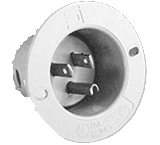I was accepted into college for an electrical construction and maintenance program. I got a job box for my b-day. I was wondering what the best way is to run an extension cord into it to charge batteries for drill, saw, etc. would like to keep the box locked and the hole water tight. My dad and I thought of drilling a hole in the side and running an extension cord though a compression fitting on a 4x4 box with a receptacle. I was worried about grounding and securing it if there are any ideas they are greatly appreciated thanks so much.
First off I want to congratulate you on a pursuit of a formal education!
I underlined your spelling errors, don’t be surprised while in school if the teacher deducts points just for bad spelling. It cost me greatly once - a whole letter grade on a paper! I almost always use a true word processor, and not only checks spelling errors but also composition errors.
I’ve seen this application of a power tool box before and frankly IMPO I’m kind of leery of it.
Consideration must be made for future usage, in that, one day you will drag the tool box out into a working environment.
A standing OSHA requirement is that all temporary receptacle power usage must be GFCI protected. You could do this by just using one in your installation.
If your in California and on a job you are required to have twist lock receptacles and plugs, now this was based on my reading here. I’ll assume that this is really only followed on larger construction jobs!
My only leery part is most applications I’ve seen is where the receptacle is only on the inside, and devices and power cords are plugged in and the lid is shut down and even locked with cords hanging out!
Now I understand the need or desire for your new (toy) box to maintain it’s pristine condition. You can also get paint for your tool box from the manufacture, and paint the box(s) and the future scraps!
Here’s what I’d do.
I’d use two boxes, maybe even three. One cast on the outside, which would be is a two device box, for a receptacle and a GFCI, maybe just a one device box. The GFCI should be wired to protect everything.
The outside box will also need a weather cover, if you use devices on an outside box((now this is my opinion and not a standing OSHA or NFPA offense - your tool box is not a structure it’s mobile))
I might have that totally wrong about the cover!
Or just use a single cast box, with a GFCI on the outside. You can also install a fake box to act as a bumper on the other side, and equal up the space of your shape! This might also add in some protection of the coiled length of power cord.
I’d use only SO cord with a stain relief to the bottom of an outside box.
If you use two boxes you can just use a chase nipple, with lock nuts between boxes that are back to back. I’d also use a heavy duty male plug. Use a all plastic plug, the metal banded receptacle is a OSHA violation, and they still sell them! SO cord will need a equally applicable SO receptacle. In any case I’d use anti thief nuts, and I’d also look into using anti-tamper 8/32 screws on any exposed covers.
I’d also consider just use one ninety degree into one box thats inside.
Maybe there is enough space to tuck the connector inside a cavity depending on the type of tool box you have.
As far a bonding the device boxes; One is bonding the non current carrying conductor to the box, the box is mechanically connected to the structure, that all that’s required.
As far as the cast box, I’d drill and use short all thread bolts right through the cast boxes. If you use an outside box, I’d also use the outside loop holes that are on the cast box but only for cosmetic purposes, use small mushroom head bolts there, all with anti thief bolts inside, JMO.
The bond slot in cast boxes are notorious for stripping even with an average attachment of the bonding screw, be careful and Good Luck!




